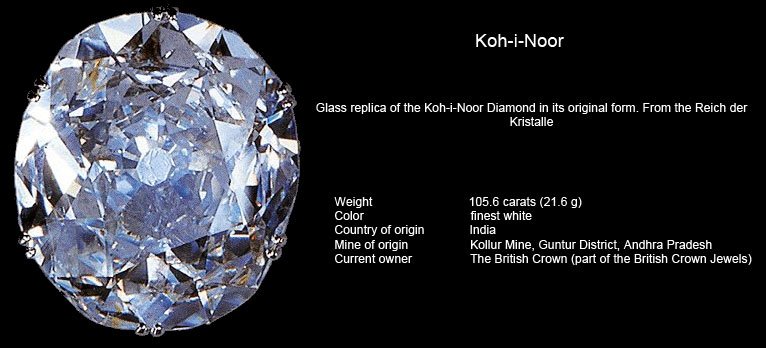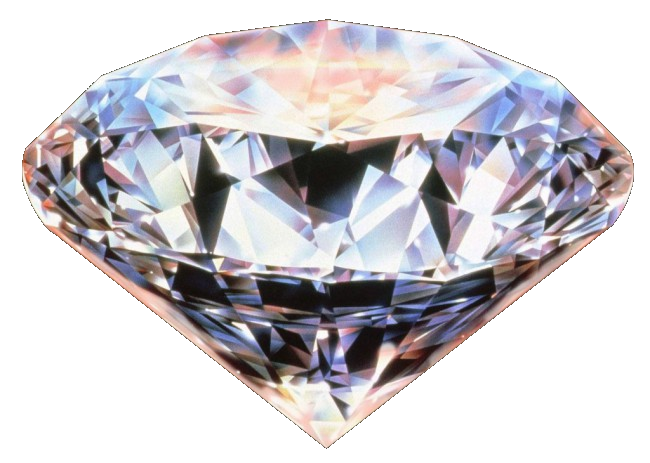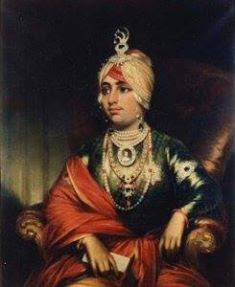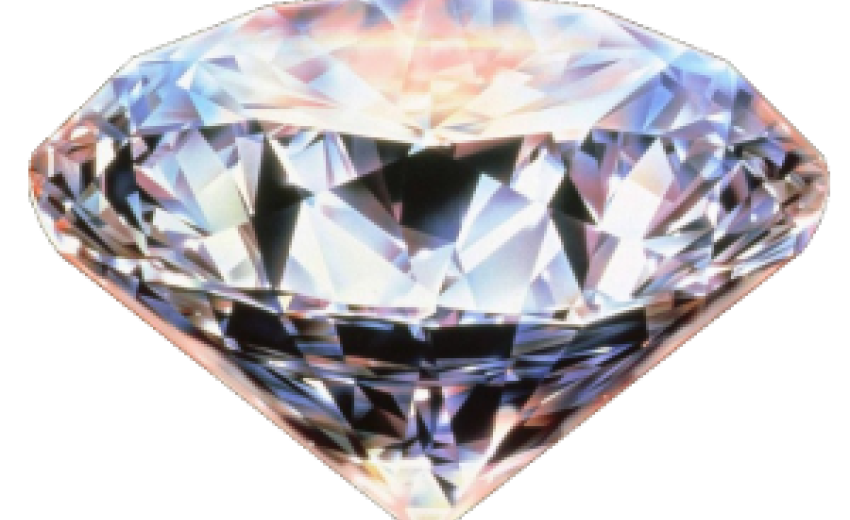Who really owns the Koh-i-Noor Diamond? ~ Part I

Recently, we read about the very unrealistic "demand" for the Koh-i-Noor diamond to be returned to the Sikhs. A number of mixed reactions, were observed. They were mostly based on no understanding of politics, nor of the history, of the diamond.
The issue of the Koh-i-Noor diamond rears it's head from time to time, largely since 1984. No doubt there is a lot of interest over the issue, there is little understanding of the circumstances around it. Thus we often see very mixed bag of knee jerk reactions of especially Sikhs, over it.
Over the years, although the Koh-i-Noor diamond is no longer the largest or most expensive, but it remains one of the most heatedly discussed topic to this day.
It's infamous colourful history begins long long time before Maharajah Ranjit Singh-Shere i-Punjab -- the Lion of Punjab, where in his treasury it remained the most treasured and magnificiently valuable single item.
In a few short years, after Maharajah Ranjit Singh's untimely demise, it came to be owned by the infant King, Maharajah Duleep Singh son of Mahrajah Ranjit Singh.
The British, after four fierce battles, eventually defeated the powerful Sikh army, more so through treachery than on the battlefield, took control of the Sikh State Raj, and the infant king Mahrajah Duleep Singh. As part of the war reparations, took away the diamond Koh-i-Noor, and presented it to Queen Victoria "on behalf of the people of India"
To this day, it remains embedded in the Royal Crown of the Queen and is kept with Royal Crown Jewels, in London.

Fast backward in history
The Koh-i-Noor ~ "Mountain of Light"; is a 105 carat (21.6 g) diamond that was once the largest known diamond in the world. The Koh-i-noor originated in the state of Andhra Pradesh in India, belonged to various Indian and Persian rulers who fought bitterly over it at various points in history, and seized it as a spoil of war, became part of the British Crown Jewels when British Prime Minister Benjamin Disraeli proclaimed Queen Victoria "Empress of India" in 1877.
Like all significant jewels, the Koh-i-noor has its share of legends. It is reputed to bring misfortune or death to any male who wears or owns it. Conversely, it is reputed to bring good luck to female owners.
The origins of the diamond are unclear. Many early stories of great diamonds in southern India exist, but it is hard to establish which one was the Koh-i-noor, if any.
According to some sources, the Koh-i-Noor was originally found more than 5000 years ago, and is mentioned in ancient Sanskrit writings under the name Syamantaka. Hindus believe that Krishna himself obtained the diamond from Jambavantha, whose daughter Jambavati later married Krishna. The legend says that the diamond was stolen from Krishna as he lay sleeping. Another source claims that the diamond was discovered in a river bed in 3200 BCE.
Historical evidence suggests that the Koh-i-noor originated in Golkonda kingdom, in Hyderabad state of Andhra Pradesh, one of the world's earliest diamond producing regions. South Indian folklore is definite in claiming a local origin for the stone. It is certain that the stone was mined in India, as until the 19th century India was the only place in the world where diamonds were known. It is likely that the diamond was mined in the Kollur mines in the present day Guntur district of Andhra Pradesh.
The Khilji dynasty at Delhi ended in 1320 C.E and Ghiyas ud din Tughluq Shah ascended the Delhi throne. Tughlaq sent his son Ulugh Khan in 1323 C.E to defeat the Kakatiya king Prataparudra. Ulugh Khan's raid was repulsed but he returned in a month with a larger and determined army. The unprepared army of Warangal was defeated. The loot, plunder and destruction of Warangal continued for months. Loads of gold, diamonds, pearls and ivory were carried away to Delhi on elephants and camels. The Koh-i-noor diamond was part of the bounty. From then onwards, the stone passed through the hands of successive rulers of the Delhi sultanate, finally passing to Babur, the first Mughal emperor, in 1526.
The first confirmed note historically mentioning the Koh-i-noor by an identifiable name dates from 1526. Babur mentions in his memoirs, the Baburnama, that the stone had belonged to an un-named Rajah of Malwa in 1294. Babur held the stone's value to be such as to feed the whole world for two days. The Baburnama recounts how this Rajah of Malwa was compelled to yield his prized possession to Ala ud din Khilji; it was then owned by a succession of dynasties that ruled the Delhi sultanate, finally coming into the possession of Babur himself in 1526, following his victory over the last ruler of that kingdom. However, the Baburnama was written c.1526-30; Babur's source for this information is unknown, and he may have been recounting the hearsay of his day. He did not at that time call the stone by its present name, but despite some debate about the identity of 'Babur's Diamond' it seems likely that it was the stone which later became known as Kohinoor.
The Mughal Emperor Shah Jahan - famous for building the Taj Mahal - had the stone placed into his ornate Peacock Throne. When Shah Jahan's son, Aurangazeb, put his ailing father under house arrest at nearby Agra Fort, legend has it that he had the Koh-i-noor stationed against a window so that Shah Jahan could look at the stone and see the Taj reflected in it. There it stayed until the invasion of Nadir Shah in 1739 and the sacking of Agra and Delhi. Along with the Peacock Throne, he also carried off the Koh-i-noor to Persia in 1739. It was allegedly Nadir Shah who exclaimed Koh-i-Noor! when he finally managed to obtain the famous stone, and this is how the stone gained its present name. There is no reference to this name before 1739.
The valuation of the Koh-i-noor is given in the legend that one of Nadir Shah's consorts supposedly said, 'If a strong man should take five stones, and throw one north, one south, one east, and one west, and the last straight up into the air, and the space between filled with gold and gems, that would equal the value of the Koh-i-noor'
After the assassination of Nadir Shah in 1747 it came into the hands of Ahmed Shah Abdali of Afghanistan. In 1830, Shah Shuja, the deposed ruler of Afghanistan, managed to flee with the Kohinoor diamond. He then came to Lahore, the capital of Maharaja Ranjit Singh, where it was given to the Sikh Maharaja (King) of Punjab Ranjit Singh, in which after, in return, Maharaja Ranjit Singh was able to persuade the East India Company to lend their troops and win back the Afghan throne for Shah Shuja.
Maharajah Ranjit Singh crowned himself as the ruler of Punjab and it is claimed by many Indian writers that Maharajah Ranjit Singh willed the Koh-i-noor to Jagannath Temple in Orissa while on his deathbed in 1839. But there was dispute about this last-minute testament, and in any case it was not executed, neither factual history provides any facts.
On March 29, 1849, the British flag was hoisted on the citadel of Lahore and the Punjab was formally proclaimed to be part of the British Empire in India. One of the terms of the Treaty of Lahore, the legal agreement formalising this occupation, was as follows: The gem called the Koh-i-Noor which was taken from Shah Shuja-ul-Mulk by Maharajah Ranjit Singh shall be surrendered by the Maharajah of Lahore to the Queen of England.
The Governor-General in charge for the ratification of this treaty was Lord Dalhousie. More than anyone, Dalhousie was responsible for the British acquiring the Koh-i-Noor, in which he continued to show great interest for the rest of his life. Dalhousie's work in India was sometimes controversial, and his acquisition of the diamond, amongst many other things, was criticised by some contemporary British commentators. Although some suggested that the diamond should have been presented as a gift to the Queen, it is clear that Dalhousie felt strongly that the stone was a spoil of war, and treated it accordingly. Writing to his friend Sir George Cooper in August of 1849, he stated this: The Court [of the East India Company] you say, are ruffled by my having caused the Maharajah to cede to the Queen the Koh-i-noor; while the 'Daily News' and my Lord Ellenborough [Governor-General of India, 1841-44] are indignant because I did not confiscate everything to her Majesty... "my motive was simply this: that it was more for the honour of the Queen that the Koh-i-noor should be surrendered directly from the hand of the conquered prince into the hands of the sovereign who was his conqueror, than it should be presented to her as a gift -- which is always a favour -- by any joint-stock company among her subjects. So the Court ought to feel proud of the subjects.

Dalhousie arranged that the diamond should be "presented" by, Maharajah Duleep Singh, to Queen Victoria in 1851. The presentation of the Koh-i-Noor to Queen Victoria was the latest in the long history of transfers of the stone as a spoil of war.
The British public were given a chance to see the Koh-i-Noor when the Great Exhibition was staged in Hyde Park, London in 1851. The correspondent of The Times reported: "The Koh-i-Noor is at present decidedly the lion of the Exhibition. A mysterious interest appears to be attached to it, and now that so many precautions have been restored to, and so much difficulty attends its inspection, the crowd is enormously enhanced, and the policemen at either end of the covered entrance have much trouble in restraining the struggling and impatient multitude. For some hours yesterday there were never less than a couple of hundred persons waiting their turn of admission, and yet, after all, the diamond does not satisfy. Either from the imperfect cutting or the difficulty of placing the lights advantageously, or the immovability of the stone itself, which should be made to revolve on its axis, few catch any of the brilliant rays it reflects when viewed at a particular angle"
This disappointment in the appearance of the stone was shared by many. In 1852, under the personal supervision of Victoria's consort, Prince Albert, the diamond was cut from 186 1/16 carats (37.21 g) to its current 105.602 carats (21.61 g), to increase its brilliance. Albert consulted widely, took enormous pains, and spent some £8,000 on the operation, which reduced the weight of the stone by a huge 42% - but nevertheless Albert was still dissatisfied with the result. The stone was mounted in a tiara with more than two thousand other diamonds.
Later the stone was to be used as the centerpiece of the crown of the Queens consort of the United Kingdom. Queen Alexandra was the first to use the stone, followed by Queen Mary. In 1936, the stone was set into the crown of the new Queen Elizabeth (later known as the Queen Mother), wife of King George VI. In 2002, the crown rested atop her coffin as she lay in state.
Given the long and bloody history of the diamond, there are many countries with a claim on it. In 1976, Pakistani prime minister Zulfiqar Ali Bhutto asked British prime minister Jim Callaghan for the Koh-i-Noor to be returned to Pakistan. The prime minister replied to Mr Bhutto with a polite "No", and British diplomats in the countries likely to counter this claim were asked to lobby to 'kill the story'. Other claims have been made by India, the Taliban regime of Afghanistan, and Iran. As of 2007, the gem remains in the Tower of London. The Sikhs, with no state of their too have been actively claiming it, sometimes thrown in between arguments between UK and India, and other times with India.
In "Tooth and Claw", an episode of the 2006 series of Doctor Who set in 1879, the Koh-i-Noor diamond was used by the Doctor to save Queen Victoria from a werewolf. In the story, the reason for Prince Albert cutting down the diamond was to try and make it a suitable prism for a light chamber designed to trap the werewolf. The episode was first broadcast in the UK on 22 April 2006.
In one of the George MacDonald Fraser "Flashman" novels, Flashman and the Mountain of Light (published in 1990), the Koh-i-Noor diamond forms part of the backdrop to the storyline, set during the First Anglo-Sikh War as fought between 1845 and 1846.
In Henry David Thoreau's book Walden, the appeal of the Koh-i-Noor diamond is mentioned on page 137 to make a point regarding human's quest for material goods.
In Hugh Antoine D'Arcy's poem, "The Face on the Barroom Floor" in [1887], the vagabond describes the woman that led to his ruin with the phrase, "...With eyes that would beat the Koh-i-Noor, and a wealth of chestnut hair..."
In James Joyce's "Ulysses", in the section written in dialogue, it is mentioned in his stage directions that "Bloom holds up his right hand on which sparkles the Koh-i-Noor diamond." Kohenor, Light Mountain is a painting by Shane Rickman.
